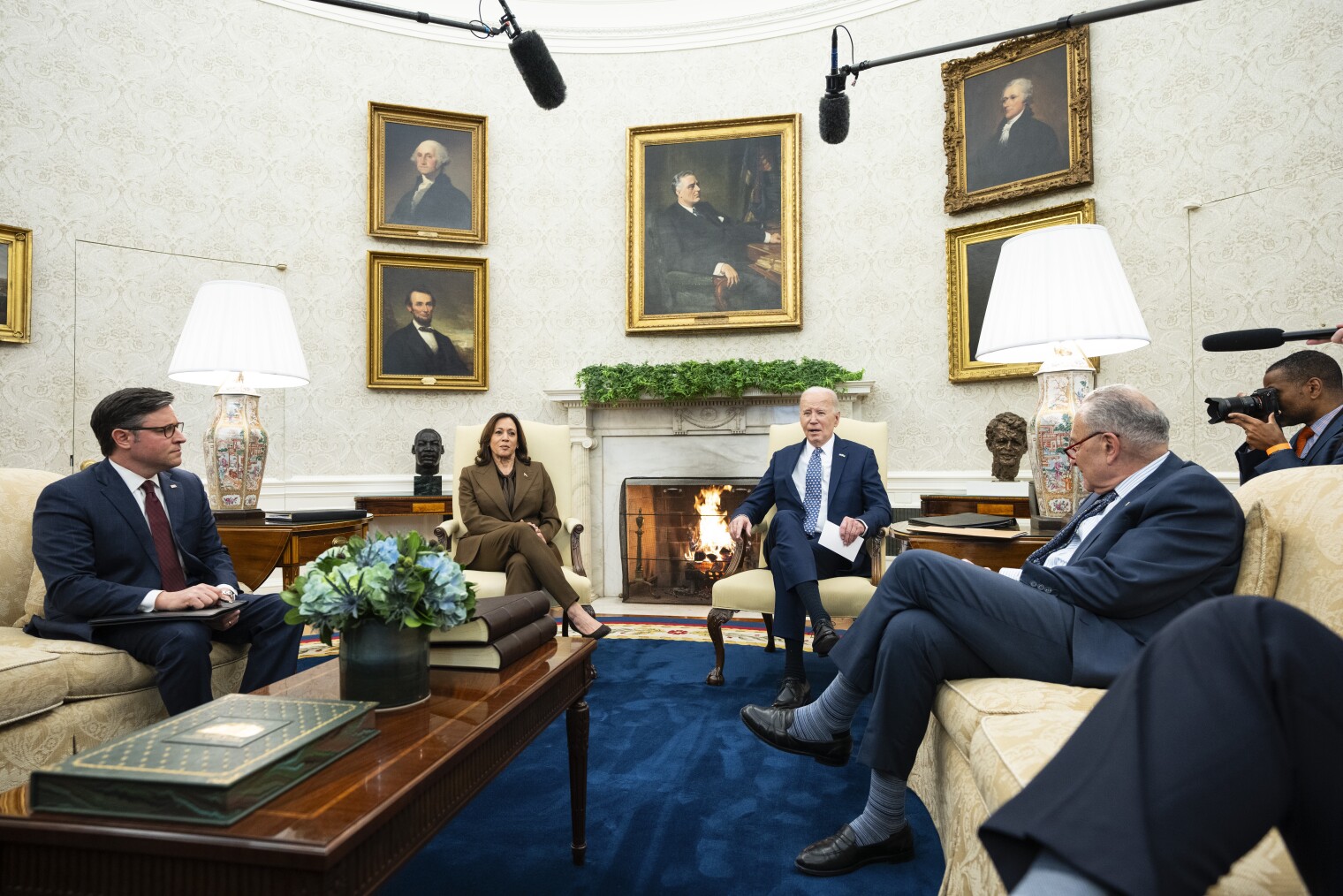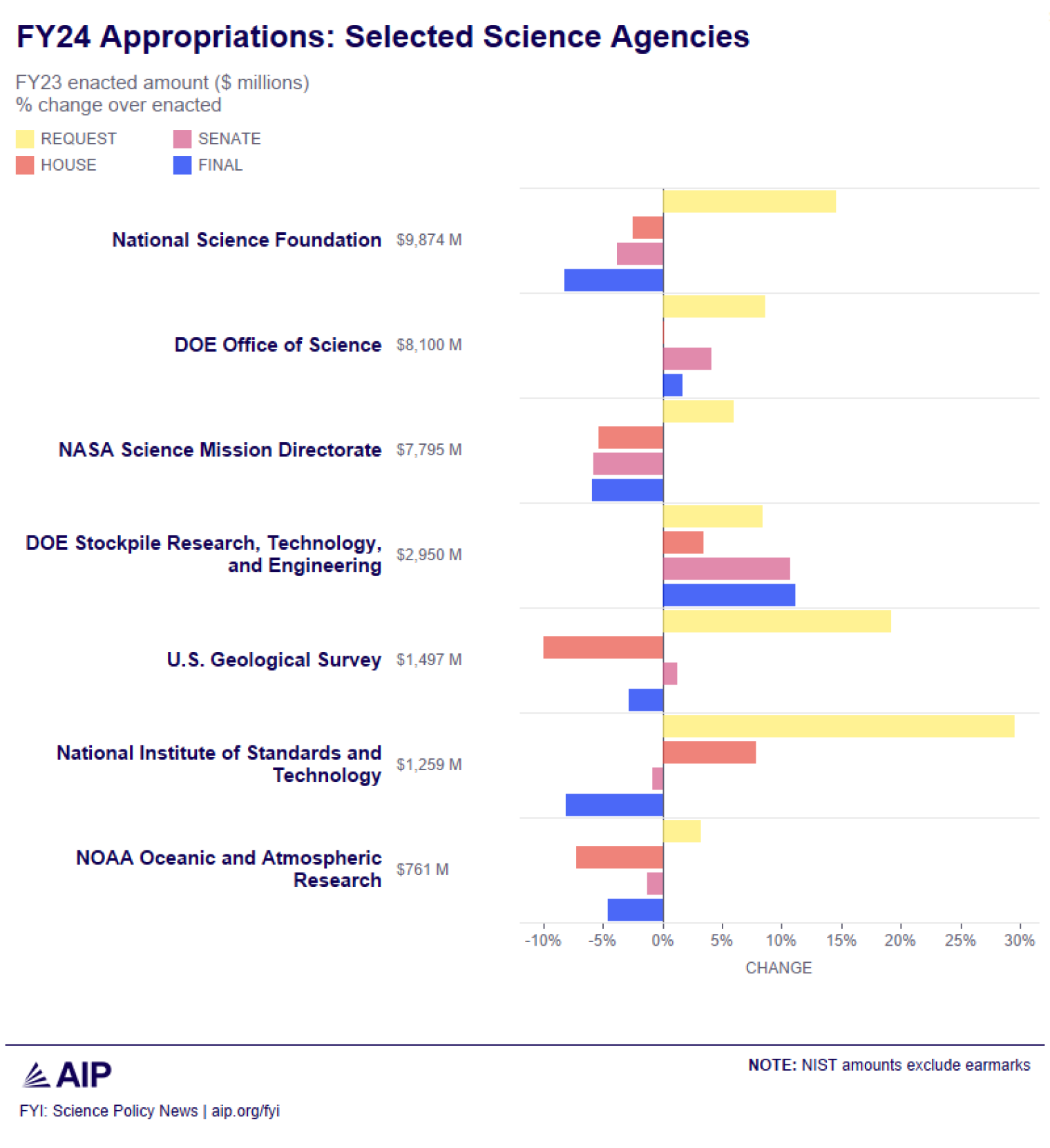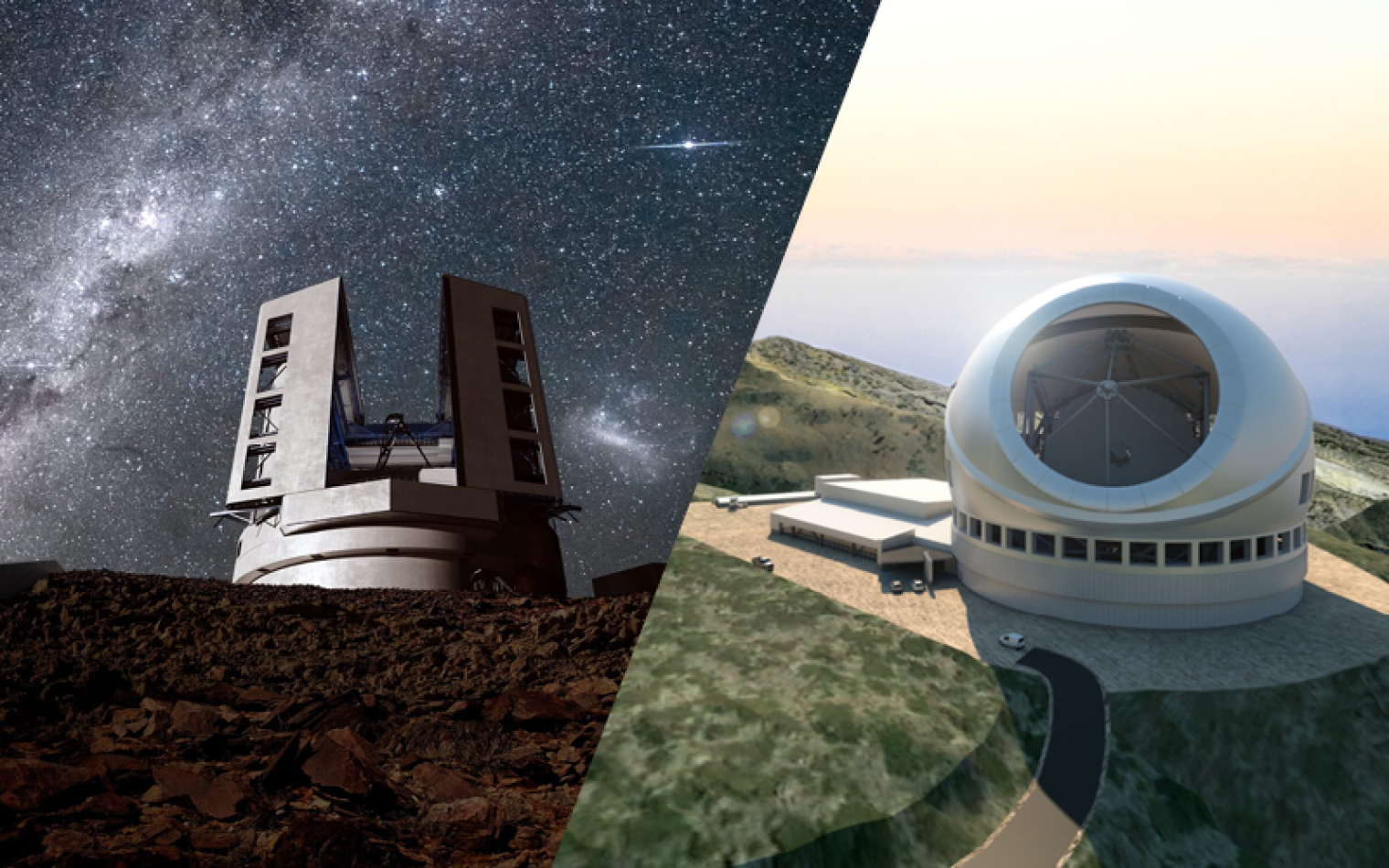| |
| FYI: Science Policy News from AIP |
| THIS WEEK |
|
|
|
|
|
|
| What’s Ahead |
 |
| From left: House Speaker Mike Johnson (R-LA), Vice President Kamala Harris, President Joe Biden, and Senate Majority Leader Chuck Schumer (D-NY) at a Feb. 27 meeting to negotiate the final federal budget for fiscal year 2024. (Evan Vucci / AP) |
Science Agencies Cut in Final FY24 Budget, Except DOE
Many science agencies will see topline budget cuts under the final appropriations agreement for fiscal year 2024, with some parts of the Department of Energy a notable exception to the trend. Since Congress agreed to hold the federal government’s overall discretionary budget to about the same level as last fiscal year, science programs often lost out to other priorities in a mostly zero-sum budget. Over the weekend, Congress posted six of the 12 appropriations bills that together fund the federal government, as well as reports that detail spending allocations for agency programs. Among them, the Energy-Water report covers DOE, the Interior-Environment report covers the U.S. Geological Survey, and the Commerce-Justice-Science report covers the National Science Foundation, National Institute of Standards and Technology, National Oceanic and Atmospheric Administration, and NASA. Congress anticipates passing the legislation in the coming days and releasing the remaining bills later this month. Details on program-level spending outcomes are available in FYI’s Federal Science Budget Tracker.
 |
| Chart of FY24 appropriations. |
Assuming the legislation is enacted, the DOE Office of Science budget will increase about 2% to $8.24 billion, within which its Isotope R&D and Production program will jump nearly 20%. The Biden administration’s hopes of a budget surge for the Fusion Energy Sciences program were not realized, with the final legislation only providing a 3.5% increase, similar in size to the increase provided for the High Energy Physics and Basic Energy Sciences programs. The legislation does, however, boost the National Nuclear Security Administration’s Inertial Confinement Fusion budget by 10%, reversing the requested cut. Some DOE science programs are still in line for flat budgets or cuts. The Office of Science’s Advanced Scientific Computing Research program will drop 5%, though an analogous program in NNSA will increase 5%. The Nuclear Physics program and the Biological and Environmental Research programs are held about flat.
NASA’s Science Mission Directorate will drop about 6% to $7.33 billion, with the cut falling entirely on the Planetary Science Division, which will drop 15% to $2.72 billion. The cut is driven by concerns over the rising cost of the Mars Sample Return mission, which the Senate had proposed potentially canceling. The legislation defers decisions about the mission’s future, anticipating the results of an internal NASA review, while directing NASA to spend at least $300 million on the mission and up to the president’s requested level of $949 million. However, the reduced Planetary Science topline will likely force the budget toward the lower end of that range, consistent with a recent, NASA-ordered slowdown of work on the mission. The directorate’s Heliophysics, Earth Science, and Astrophysics Divisions will all have flat or nearly flat budgets.
The National Science Foundation’s budget will drop about 8% to just over $9 billion, partially undoing the 12% boost NSF received in the previous budget cycle. That increase relied on a special supplemental appropriation that Congress did not sustain this year. This year’s legislation does increase NSF’s construction budget by 25%, a portion of which will go toward launching a supercomputer acquisition project, though the total is well below the requested amount.
The National Institute of Standards and Technology’s base budget will drop 8% to $1.16 billion. This figure excludes about $300 million in earmarks for research and construction projects external to NIST. Since Congress resumed earmarks in 2021, it has used NIST’s budget as the vehicle for funding many of those related to science. Meanwhile, the legislation will cut NIST’s own budget for construction and facilities repair by a third even though the agency faces a huge backlog of infrastructure modernization projects and made that work a top priority in its budget request.
Science Committee Continues Weather Policy Push with Forecasting Hearing
The House Science Committee will examine how U.S. weather models compare with those of other countries at a hearing on Wednesday. The hearing charter states that Europe operates a forecast system that is generally viewed as superior to that of the U.S., and that China has recently focused on using artificial intelligence to increase the accuracy and speed of its forecast models. One of the witnesses is Neil Jacobs, who was acting head of the National Oceanic and Atmospheric Administration during the Trump administration. At NOAA, Jacobs pushed to create the Earth Prediction Innovation Center (EPIC), which aims to make it easier for researchers outside NOAA to contribute improvements to the agency’s weather models. The other two witnesses are Aeris LLC CEO Kevin Petty and CLIMET Consulting CEO Scott Weaver, who until recently led the Interagency Council for Advancing Meteorological Services (ICAMS) and the National Windstorm Impact Reduction Program. The hearing is the latest in a series focused on weather forecasting held by the House Science Committee, which is pushing to update the Weather Research and Forecasting Innovation Act of 2017. The committee unanimously advanced legislation last year that would update the 2017 law, and the hearing charter states the committee expects the full House will vote on it sometime this month.
Physicists Gather in Minneapolis for APS March
The American Physical Society’s annual March Meeting is underway in Minneapolis, Minnesota, through Saturday. Among the policy-focused events is a special session Monday evening on broadening participation in physics. The session will explore the role of Historically Black Colleges and Universities in educating STEM students, racial disparities in grant funding outcomes at the National Science Foundation, diversity efforts at national laboratories, and how U.S. research security initiatives could create a hostile climate that drives away scientists. Research security will also be the focus of a live-streamed session Friday morning featuring speakers from industry and federal agencies. As APS is celebrating its 125th anniversary this year, an invited session on Wednesday will explore the origins of the organization, historical debates over what counts as physics, the history of women in APS, and internal divisions in APS during the Cold War and the Vietnam War. (APS is an AIP Member Society)
National Nanotechnology Initiative Marks 20th Anniversary of Authorizing Law
The National Nanotechnology Initiative will hold a day-long symposium on Tuesday in Washington, D.C., to celebrate the 20th anniversary of the 21st Century Nanotechnology Research and Development Act, which provided statutory backing for the NNI. Among the speakers are White House Office of Science and Technology Policy Director Arati Prabhakar, Sen. Ron Wyden (D-OR), and former OSTP Director Neal Lane, who was in the job when President Bill Clinton launched the NNI in 2000. The trio will discuss the NNI’s impact over the years, and other sessions will explore the future of nanotechnology, how to develop the technology responsibly, workforce and infrastructure needs, and technology commercialization. Notably, last year the President’s Council of Advisors on Science and Technology put out a report that recommended sunsetting or substantially revising the Nanotechnology R&D Act, arguing that “the federal organizational structure that was effective in the early 2000s for nanotechnology as an emerging technology should be reconsidered in the context of nanotechnology as a mature field.”
Major Research Security Conference Underway in Texas
The eighth annual Academic Security and Counter Exploitation seminar runs through Friday this week, organized by Texas A&M University System. The event has become a major conference for research security professionals, and this year’s edition includes a video address from House Foreign Affairs Committee Chair Michael McCaul (R-TX) and keynote addresses from officials at the FBI, National Security Council, National Science Foundation, and State Department. As part of the event, on Thursday the National Science, Technology, and Security Roundtable of the National Academies will hold its 13th meeting. Officials from the UK, South Korea, Canada, and the European Commission will offer their perspectives on research security at the roundtable meeting.
|
|
| In Case You Missed It |
 |
| Renderings of the Giant Magellan Telescope, left, and the Thirty Meter Telescope. (Left: GMTO Corporation / Right: M3 Engineering) |
NSF Poised to Downsize Telescope Ambitions, But Appropriators Send Opposite Signal
The National Science Foundation’s governing board signaled last week that the agency is unlikely to have enough money to fund construction of both the Thirty Meter Telescope (TMT) and the Giant Magellan Telescope (GMT), which are competing against an array of other high-priority infrastructure proposals across scientific disciplines. The board set a $1.6 billion ceiling on NSF’s contribution of construction funds for the telescopes and has asked the agency to report back by May on “its plan to select which of the two candidate telescopes the agency plans to continue to support.” A board spokesperson added, “Based on what the board knows now, it anticipates that a down-selection will be necessary.” However, the final appropriations legislation for NSF released this week “strongly encourages” the board to pursue a “two-observatory footprint with a mechanism to guarantee robust community access.” Funding both telescopes would likely require a significant and sustained boost to NSF’s Major Research Equipment and Facilities Construction (MREFC) account. The board has cautioned that even if NSF limits its contribution to $1.6 billion, the effort would consume about 80% of NSF’s historical MREFC budget.
NASA Cancels Big-Budget Robotic Servicing Demonstration
NASA announced on March 1 that it is terminating its On-Orbit Servicing, Assembly and Manufacturing 1 (OSAM-1) mission, which was supposed to have refueled Landsat 7, demonstrating capabilities for robotically servicing satellites not designed to be serviced. The mission, formerly called RESTORE-L, also incorporated a robotic arm called Space Infrastructure Dexterous Robot (SPIDER) that would have assembled a 3-meter communications antenna and a 10-meter beam. Congress has strongly supported OSAM-1, appropriating about $1.5 billion to date and often exceeding the amounts annually requested for it. However, the project’s cost and schedule estimates have been unstable, with the price tag currently pegged at more than $2 billion. NASA states its termination decision is linked to “continued technical, cost, and schedule challenges, and a broader community evolution away from refueling unprepared spacecraft, which has led to a lack of a committed partner.” Last year, NASA’s Office of Inspector General highlighted poor performance by the contractor Maxar as a key cause of the project’s ongoing difficulties. NASA’s Goddard Space Flight Center in Maryland has been developing OSAM-1 and the agency states it is “reviewing how to mitigate the impact of the cancellation” on the center’s workforce.
PCAST Calls for Nationwide Greenhouse Gas Monitoring Effort
The President’s Council of Advisors on Science and Technology (PCAST) released a report on Feb. 20 recommending that government agencies create a “common operating picture” for tracking greenhouse gas emissions, particularly methane, to monitor progress toward the goal of achieving net-zero greenhouse gas emissions by 2050. Even though there is far more carbon dioxide in the air, methane is more potent, responsible “for approximately 30% of today’s climate warming,” PCAST says. The system would ideally be unified, centralized, complete, and on a national scale, but also have the ability to provide localized data when needed. Another recommendation calls for a multi-decadal strategy to develop new and better emissions-monitoring sensors and satellites. The report also “fully endorses” recommendations published last year by an interagency working group on emissions monitoring, which proposed establishing a National Greenhouse Gas Monitoring and Information Office.
Senate Confirms Inaugural Assistant Secretary of Defense for Science and Technology
By voice vote, the Senate confirmed Aprille Joy Ericsson as the first assistant secretary of defense for science and technology on Feb. 28. Ericsson has worked at NASA for three decades, most recently as a lead business strategist at the Goddard Space Flight Center, and President Joe Biden nominated her for the new position last September. The Department of Defense created the role through a reorganization that replaced three deputy chief technology officer roles with three equivalent assistant secretary positions requiring Senate confirmation. Nominees for the other two roles, the assistant secretary of defense for mission capabilities and assistant secretary of defense for critical technologies, have yet to be announced. Ericsson will oversee the Small Business Innovation Research (SBIR) program as well as policy affecting the defense STEM workforce, labs, and test infrastructure. The role will also focus on four of the 14 technology areas deemed critical by DOD: quantum science, advanced materials, biotechnology, and next-generation wireless networks.
NSF Appoints Science Policy Scholar as Head of Social Sciences Directorate
The National Science Foundation has selected science policy expert Kaye Husbands Fealing to lead the Directorate for Social, Behavioral and Economic Sciences. Husbands Fealing is the dean of Georgia Tech’s College of Liberal Arts and formerly chaired its School of Public Policy. She holds a doctorate in economics from Harvard University and a bachelor’s in mathematics and economics from the University of Pennsylvania. Husbands Fealing has previously worked with NSF in multiple capacities, including as inaugural program director for the Science of Science and Innovation Policy program and chair of the Committee on Equal Opportunities in Science and Engineering. Her appointment, announced Feb. 29, will begin April 22.
US Capacity for International S&T Collaboration Gets Check Up from White House
The White House published a report last week on federal efforts to improve U.S. capacity for international science and technology collaboration, responding to a biennial reporting requirement from Congress. The report assesses progress toward implementing 16 recommendations made by the previous biennial report. Produced by an interagency panel, the report also discusses some of the current geopolitical challenges impacting scientific collaboration, such as Russia’s war against Ukraine, and highlights diplomacy efforts focused on emerging technologies that will be important to the future of the U.S. economy. “International S&T cooperation has been a pillar of U.S. foreign policy since the end of World War II, and it is at risk of deteriorating at a time when it is more important than ever in an increasingly competitive geopolitical climate,” the report concludes.
|
|
| Upcoming Events |
All events are Eastern Time, unless otherwise noted. Listings do not imply endorsement. Events beyond this week are listed on our website.
Monday, March 4
Tuesday, March 5
Wednesday, March 6
Thursday, March 7
Friday, March 8
No events.
Monday, March 11
Know of an upcoming science policy event either inside or outside the Beltway? Email us at fyi@aip.org.
|
|
| Opportunities |
|
Deadlines indicated in parentheses.
Job Openings
Solicitations
Know of an opportunity for scientists to engage in science policy? Email us at fyi@aip.org.
|
|
| Around the Web |
|
News and views currently in circulation. Links do not imply endorsement.
White House
Congress
Science, Society, and the Economy
Education and Workforce
Research Management
Labs and Facilities
Space
Weather, Climate, and Environment
Energy
Defense
Biomedical
International Affairs
|
|
|
| |
| This message is sent to you because your email address is on our subscribers list. To manage your AIP preferences and subscriptions, please click here. Or to automatically unsubscribe from all AIP emails, click here. AIP, 1 Physics Ellipse, MD 20740-3841
301.209.3100 - newsletters@aipcomm.org As a 501(c)(3) non-profit, AIP is a federation that advances the success of our Member Societies and an institute that engages in research and analysis to empower positive change in the physical sciences. The mission of AIP (American Institute of Physics) is to advance, promote, and serve the physical sciences for the benefit of humanity.
|
|
| © 2024. American Institute of Physics |
|
|